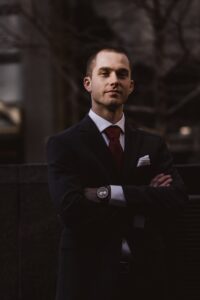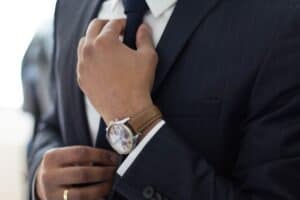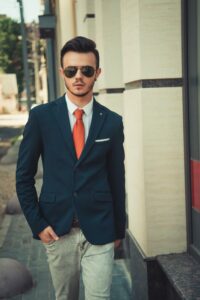The image you project is a vital part of visual communication and key to a successful interview. First impressions are formed within 7 seconds of meeting someone and 55% of people judge others by their physical appearance.
It can be stressful trying to figure out the rules of what to wear to a job interview. What is a formal business outfit? What is casual business outfit? This article answers those questions and gives you detailed head-to-toe guidance on how to dress for your job interview.
In a nutshell, for a formal business outfit, wear a 2-piece suit and button down shirt in neutral colors. In a business casual environment, you can dress more casually. But whatever you are wearing, make sure your outfit is clean, polished and neat.
With that in mind, let’s walk you through choosing the best interview outfit to wear to your next job interview.
Factors to consider when choosing a job interview outfit

What is the professional image you want to project?
For example, a ‘power suit’ will give the impression of power and leadership while a more relaxed ensemble gives the impression that you are friendly and work well in a team.
What colors suit you?
Some colors will make you look washed out and tired while others make you look alive and energetic. Colors also send different messages. I go into detail about this later.
How much do you have to spend on an interview outfit?
While it is ideal to have the ‘perfect outfit’ for every interview, what’s even better is to have some clothes in your closet that you could incorporate into your ensemble.
It might be more money upfront but buying a good quality set of clothes that you can wear repeatedly to most interviews is worth it if it snags you your dream job.
Tip: If it’s been awhile since you wore your interview suit, make sure it still fits long before the interview so that you can make adjustments or buy a new suit if needed.
The weather
In winter, most business clothes will keep you warm and snug but in summer, choose lighter clothes with breathable fabrics to keep you cool and dry.
What is the company dress code?
Research how formal the workplace is. You can snoop online via the company website or Linkedin. You can also ask company contacts or even the HR person who arranged the interview with you. Always dress a bit more professionally than the average employee at the company.
In general, you would choose to wear business formal or business casual attire. If you are attending a job interview for a position in finance or law, formal business attire would suit better. For most other positions, business casual is generally the best option.
Business Formal Attire

What is business formal attire?
Business formal is the highest level of professional attire. Think Allie McBeal or Suits. The standard dress code is a full (not separates) tailored business suit. Colors tend to be conservative with minimal accessories.
Dressing business formal isn’t about self-expression. It is about following the rules.
Suit
The foundation piece of your interview outfit is a tailored (or at least well-fitting) two-piece suit. Choose solid dark colors like black, dark grey or navy blue. Lighter suit colors are frowned on and thought to be too casual. The suit material should be high quality, for example, wool or wool blend.
In a pinch, you can pair separate pants and a suit coat but that is considered business casual more than business formal.
Shirt
Button-up collared shirts are a must. Acceptable shirt colors are white, cream, beige or light blue. Subtle pinstripes are fine too as long as it coordinates with the suit. Any bolder color or pattern is inching into rebel country.
Tie
Invest in a high quality silk tie. With ties, you can go for slightly bolder colors or patterns that match your suit and shirt. Still, aim for a neutral look. Anything too bold will make you stand out like a sore thumb.
Belt
Only black or brown leather belts are acceptable. And your belt needs to match your shoes in color and finish.
Socks
Wear dress socks in a color that matches your suit and shoes. Make sure it goes up to mid-calf level so you don’t show your ankles when you sit down.
Shoes
Wear leather shoes in dark brown or black. If your suit is gray or black, wear black shoes. If your suit is blue, wear brown shoes.
Your shoes and belt should match in color and finish. Make sure your shoes are clean and polished.
Accessories
If you are wearing cufflinks or pocket squares, make sure they match your suit. A classic wristwatch with a leather or metal band is acceptable.
Wearing your wedding ring is fine but avoid wearing other rings. Earrings, nose rings and all other visible body piercings should be removed. Cover up any visible tattoos.
Carry a leather briefcase or laptop bag for your documents.
Business Casual Attire

What is business casual attire?
Business casual is defined as dressing professionally without being overly formal. It’s that sweet spot between a formal suit and ‘jeans and t-shirt’. However, this definition can mean different things in different companies and industries. It can also vary due to other factors like culture and the city you are in.
When a company says they have a business casual dress code, it’s best to find out the specifics of what they really mean by that when dressing for your interview. When in doubt, it’s better to err on the side of dressing too formally than too casually.
Jacket
Instead of wearing a 2-piece suit, you can get away with sporting a grey, black or navy blue blazer. In some industries, you might be able to wear a lightweight sports jacket. In winter, look smart in a lint-free sweater over a button-down shirt.
To upgrade your look further, wear a jacket with texture, for example, a tweed jacket. Adding texture to your outfit instantly elevates your sense of class and style.
Shirt
You will still need to wear a button-down shirt with collar and long sleeves. Preferably it should be in a light or neutral color like light blue, cream or white. Vibrant colors like red, green , orange, purple or even black might look great on you but they can be distracting and unprofessional in an interview setting.
If you are choosing a print shirt, the print should be small and subtle.
Pants
You can wear dress pants but neatly-pressed chinos, wool pants, cotton pants or khakis are acceptable too. Wear them in neutral colors like black, grey, brown or navy blue.
Tie
In dressing business casual, a tie is not always a necessity, especially if the company has a more relaxed dress code.
If you are wearing a tie, a solid colored tie that complements your jacket and shirt is always safe. Patterned and multi-colored ties are fine too as long as it matches your look and isn’t too flashy.
A silk or knit tie is preferable and adds to your sense of class.
Belt
Your belt should be leather and should match your shoes in color and finish.
Socks
Solid-colored dress socks that match your outfit and come up to mid-calves are important. Most pants will pull up when you sit down to expose your ankles.
Shoes
Your belt and shoes should match in color and finish. Leather shoes are best. But you can also wear brown or black loafers, oxfords or other professional closed-toe shoes.
Accessories
Keep accessories for your Saturday night out. At most, wear a classic wrist watch with a metal or leather band and maybe a tie bar.
Carry a classy leather satchel or briefcase for your documents.
Other important details to pay attention to
The condition of your interview outfit
Make sure your interview outfit is clean with no dirt and stains, especially at the collars and cuffs. Ties also tend to collect food stains after a while. Remove lint.
Also check for holes, missing buttons or loose threads.
Grooming
Good grooming is a vital part of a polished presentation. Make sure your hair is cut and styled neatly. If you have facial hair, make sure it is shaved or trimmed.
Your nails must be trimmed and clean. Wear a neutral cologne or aftershave.
If you have tattoos, as much as it is a part of your personality, cover them for the interview.
What message do the colors of your clothes send?

Black conveys power and authority but it can also suggest drama. If you are attending an interview in a conservative field like law or finance, this is a good color to wear. However, in a more casual office, black can make you look unapproachable. Instead of wearing black jacket and pants, you could opt for a black tie instead.
Blue evokes trust, stability and honesty.
White indicates cleanliness, precision and simplicity
Grey conveys sophistication, calmness, balance and intelligence. This is a great suit color as it allows you to look powerful but is not as dominating as black.
Brown denotes calmness and dependability. It can also be associated with intelligence.
Red is a very strong color and is associated with energy and passion but can also suggest aggression.
Purple, green, yellow and orange project creativity but are not associated with feelings of trust and commitment.
In general, tried and true neutral interview colors work best. However, if you want to add a pop of color to your outfit, limit the number of brightly colored items to one small item. For example, wear a yellow tie, not a green suit.
What not to wear to a job interview
It goes without saying that whatever you wear to a job interview needs to be clean, neatly pressed and not in need of repair.
However, there are a few things that you should never wear to a job interview, no matter how casual the job environment is.
You should never wear:
- Headphones. You are not a teenager anymore. Headphones will make you look immature and shows you are not interested in engaging.
- Flip-flops. Keep those for the beach.
- T-shirts. No matter how casual the work environment.
- Jeans. Some casual workplaces might allow jeans but it’s still not a good idea to wear jeans to your interview.
- Hoodies, sweatshirts and sweatpants. You are going for a job interview, not a gym session.
- Cartoon ties. There is never an occasion to wear cartoon or loud ties except on father’s day.
- Athletic socks. You can destroy your whole look by letting your interviewer catch a glimpse of your white sport socks above your leather shoes.
- Athletic shoes. Unless you are interviewing to be a gym teacher.
- Shorts.
- Hats. Religious headwear is an exception but otherwise, there is no valid excuse to wear any kind of hat for any type of interview.
- Jewelry. A wedding band or society ring is fine but other rings and piercings should be removed.
- Underwear that shows from the top of your pants.
- Strong cologne or perfume. In a small interview room a strong scent can be overpowering and distracting.
Special situations
How to dress when you are going for an interview from your current workplace
You probably don’t want your current boss to know you are going for a job interview. This makes it tricky if you are going for the interview straight from work.
Wear the basics of your interview outfit for work but leave the finishing touches like your blazer and tie off. Only put them on after you have left the office for your interview.
If you think your basic interview outfit is too formal for work then you might need to bring your entire interview outfit with you and change before the interview.
If it is not possible to change before the interview and you’ll be turning up for the interview under-dressed, explain your reasons at the start of the interview. In the worst case scenario, it might be worth taking the day off and attending the interview from home.
Going for an interview in the peak of summer
In general, your interview attire doesn’t change according to the weather. However, in a business casual environment, you could choose to wear a lighter-weight jacket or none at all. You can also wear lighter-weight cotton shirts.
More importantly, allow yourself plenty of time to get to the interview so you don’t have to rush. If you can drive or sit in an air-conditioned cab, do so.
Going for an interview in creative industries
This guide is meant more for a traditional formal or casual business environment. If you are in a creative industry, the interview outfit etiquette would be different. You can definitely wear more modern styles and add more personality to your outfit.
Over to you
Have a dress rehearsal a few days before the interview to make sure everything fits properly and there are no holes or missing buttons that require mending. Make sure everything is clean, neatly-pressed and all ready for the real thing.
Ultimately, interviews are a time to show your future employer why you want to work for their company and what you can contribute. While you want to make a good impression with your interview outfit, you don’t want to be remembered solely for your ensemble.
Make classy choices so that your personality doesn’t get swallowed by your vibrant outfit.
Good luck!
If you think this article was helpful, share it with your family and friends on social media!
- What is Tencel lyocell? - April 16, 2022
- Is yak wool itchy? - April 7, 2022
- What is Tencel lyocell made of? - March 30, 2022
